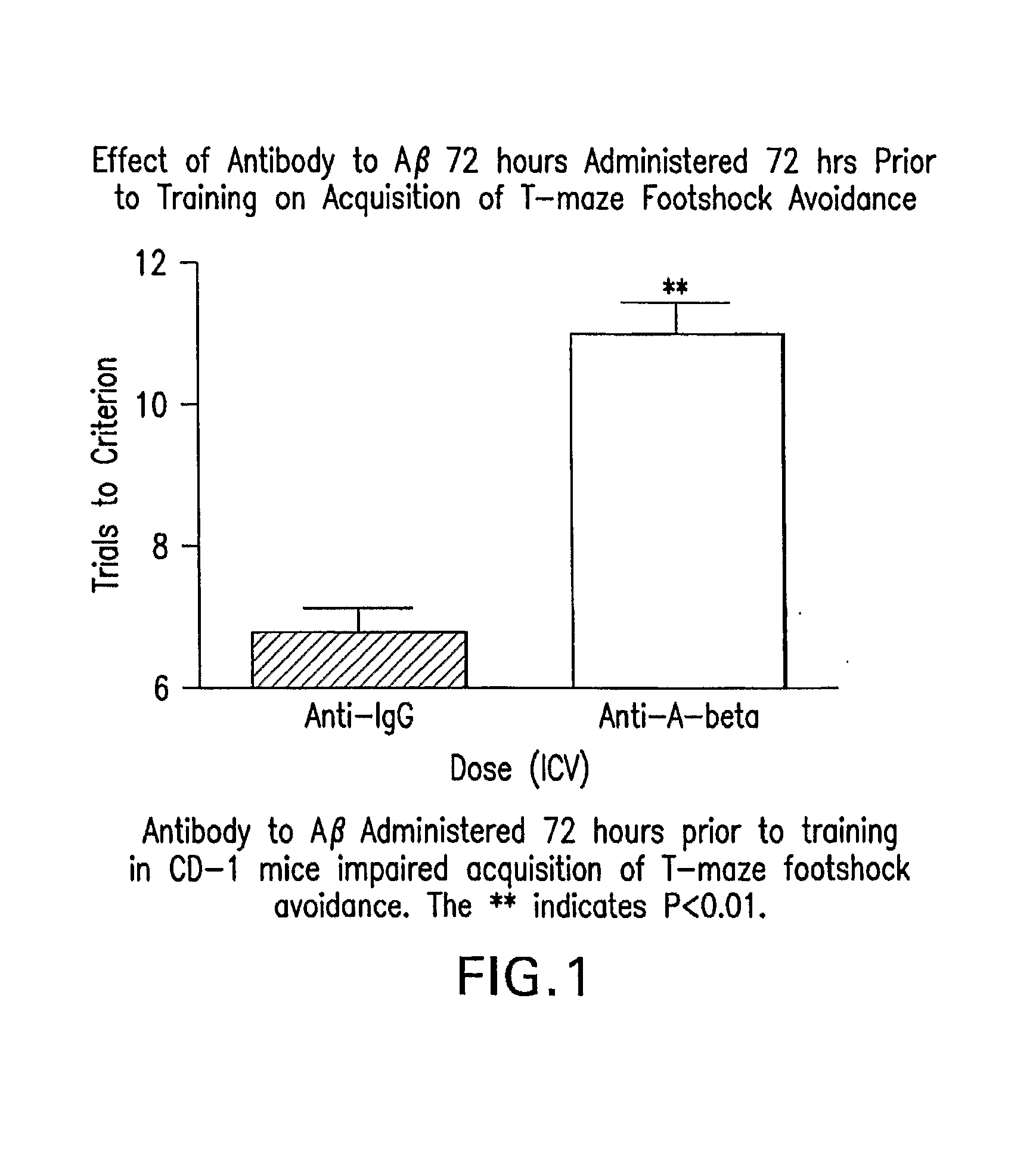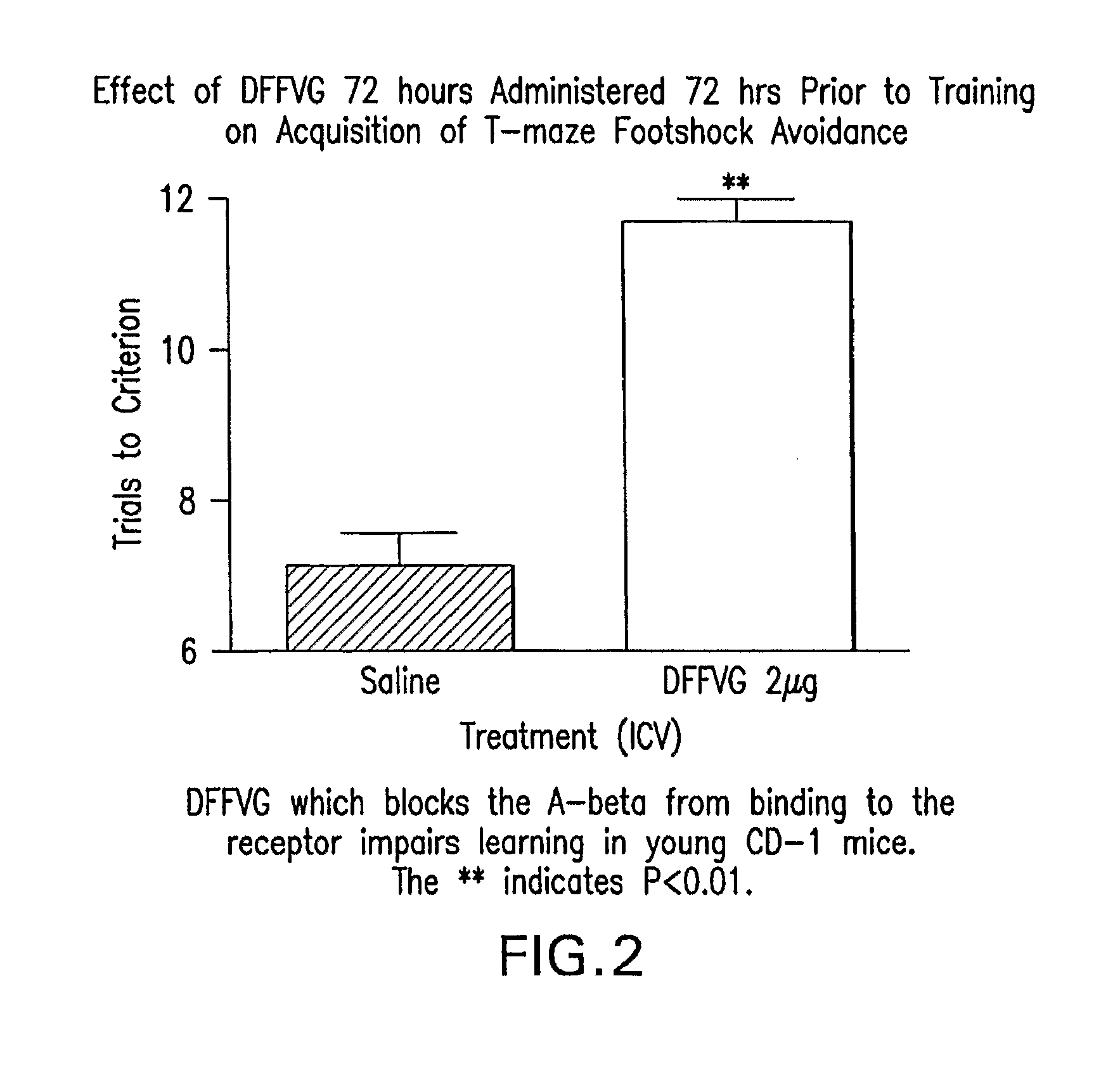Compositions and methods for enhancing cognitive function
a cognitive function and composition technology, applied in the field of compositions and methods for enhancing memory, can solve problems such as impaired learning memory, achieve the effects of improving learning memory, reducing the levels of a protein, and improving learning memory
- Summary
- Abstract
- Description
- Claims
- Application Information
AI Technical Summary
Benefits of technology
Problems solved by technology
Method used
Image
Examples
example 1
Aβ Peptides Enhance Memory Function in Mammals and Down-Regulators of Aβ Reduce Memory Function in Otherwise Healthy Mammals
[0051]SUMMARY: The inventors examined several ways of blocking endogenous Aβ in healthy 2 month old CD-1 mice. In a first study, mice were injected with 2 μl of the antibody to Aβ or Antibody to IgG as a control intracerebroventricularly (ICV) 72 hrs prior to training. Mice were trained in T-maze footshock avoidance. Antibody to Aβ impaired acquisition of T-maze footshock avoidance. In second study, the inventors blocked Aβ with a peptide, which blocks the amino acid sites 18-22 on Aβ peptide inactivating a crucial site for learning and memory on the peptide. When administered 72 hours prior to acquisition, the compound DFFVG (SEQ ID NO:11) impaired acquisition of T-maze footshock avoidance. The current results indicate that, in normal healthy young animals, the presence of Aβ is important for learning.
[0052]MICE: The subjects for the experiments were 8 week ol...
example 2
Bivalent (Hybrid) Antisense Molecules Modulate Cognitive Function
[0059]FIGS. 6-9 depict experiments that demonstrate the effectiveness of hybrid antisense molecules to reducing the level of Aβ, APP, presenilin-1, and BACE. The inventors envision that these and other equivalent hybrid antisense molecules can be effective in enhancing memory in subjects.
example 3
Orally Administered Antisense Oligonucleotides Cross Blood Brain Barrier in Mice
[0060]INTRODUCTION: The use of complimentary sequences to arrest translation of mRNAs was described in the late 1970's (Paterson et al., 1977; Hastie and Held, 1978; Zamecnik and Stephenson, 1978). However, use of antisense oligonucleotides for selective blockage of specific mRNAs and elucidation of the mechanisms of antisense inhibition in cells is of recent origin (Bennet et al., 1985; Milligan et al., 1993; Wagner, 1994; Walder and Walder, 1988; Crooke, 1993; Dolnick, 1991). The decrease in mRNA levels mediated by oligonucleotides at concentrations similar to those used in this investigation has been reported for several proteins (Walder and Walder, 1988; Bennett et al., 1994; Chiang et al., 1991). Cellular assays have indicated that antisense oligonucleotides containing phoshodiester or thionated linkages act through RNase H cleavage of 2′-deoxy oligonucleotides (Chiang et al., 1991; Walder and Walde...
PUM
| Property | Measurement | Unit |
|---|---|---|
| Mass | aaaaa | aaaaa |
| Mass | aaaaa | aaaaa |
| Mass | aaaaa | aaaaa |
Abstract
Description
Claims
Application Information
 Login to View More
Login to View More - R&D
- Intellectual Property
- Life Sciences
- Materials
- Tech Scout
- Unparalleled Data Quality
- Higher Quality Content
- 60% Fewer Hallucinations
Browse by: Latest US Patents, China's latest patents, Technical Efficacy Thesaurus, Application Domain, Technology Topic, Popular Technical Reports.
© 2025 PatSnap. All rights reserved.Legal|Privacy policy|Modern Slavery Act Transparency Statement|Sitemap|About US| Contact US: help@patsnap.com



